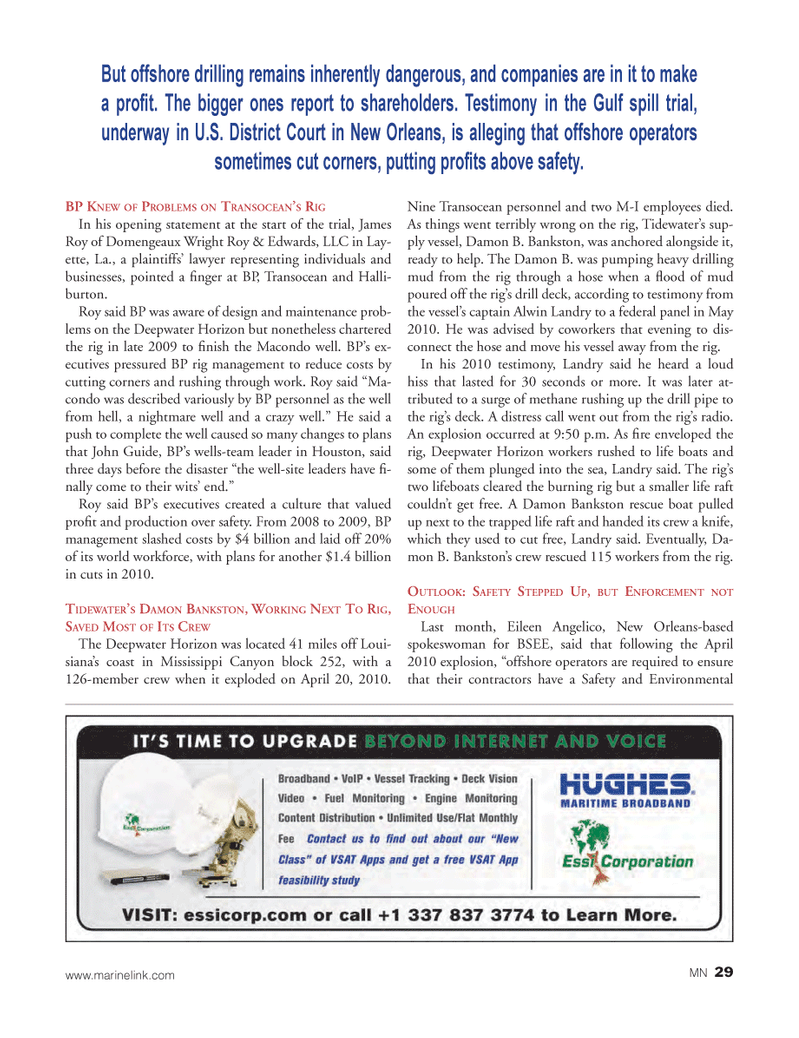
Page 29: of Marine News Magazine (April 2013)
Offshore Service Operators
Read this page in Pdf, Flash or Html5 edition of April 2013 Marine News Magazine
BP KNEW OF PROBLEMS ON TRANSOCEAN?S RIGIn his opening statement at the start of the trial, James Roy of Domengeaux Wright Roy & Edwards, LLC in Lay- ette, La., a plaintiffs? lawyer representing individuals and businesses, pointed a nger at BP, Transocean and Halli- burton. Roy said BP was aware of design and maintenance prob- lems on the Deepwater Horizon but nonetheless chartered the rig in late 2009 to nish the Macondo well. BP?s ex- ecutives pressured BP rig management to reduce costs by cutting corners and rushing through work. Roy said ?Ma- condo was described variously by BP personnel as the well from hell, a nightmare well and a crazy well.? He said a push to complete the well caused so many changes to plans that John Guide, BP?s wells-team leader in Houston, said three days before the disaster ?the well-site leaders have -nally come to their wits? end.? Roy said BP?s executives created a culture that valued pro t and production over safety. From 2008 to 2009, BP management slashed costs by $4 billion and laid off 20% of its world workforce, with plans for another $1.4 billion in cuts in 2010.TIDEWATER ?S DAMON BANKSTON , WORKING NEXT TO RIG, SAVED MOST OF ITS CREW The Deepwater Horizon was located 41 miles off Loui- siana?s coast in Mississippi Canyon block 252, with a 126-member crew when it exploded on April 20, 2010. Nine Transocean personnel and two M-I employees died. As things went terribly wrong on the rig, Tidewater?s sup- ply vessel, Damon B. Bankston, was anchored alongside it, ready to help. The Damon B. was pumping heavy drilling mud from the rig through a hose when a ood of mud poured off the rig?s drill deck, according to testimony from the vessel?s captain Alwin Landry to a federal panel in May 2010. He was advised by coworkers that evening to dis- connect the hose and move his vessel away from the rig. In his 2010 testimony, Landry said he heard a loud hiss that lasted for 30 seconds or more. It was later at- tributed to a surge of methane rushing up the drill pipe to the rig?s deck. A distress call went out from the rig?s radio. An explosion occurred at 9:50 p.m. As re enveloped the rig, Deepwater Horizon workers rushed to life boats and some of them plunged into the sea, Landry said. The rig?s two lifeboats cleared the burning rig but a smaller life raft couldn?t get free. A Damon Bankston rescue boat pulled up next to the trapped life raft and handed its crew a knife, which they used to cut free, Landry said. Eventually, Da- mon B. Bankston?s crew rescued 115 workers from the rig. OUTLOOK : SAFETY STEPPED UP, BUT ENFORCEMENT NOT ENOUGHLast month, Eileen Angelico, New Orleans-based spokeswoman for BSEE, said that following the April 2010 explosion, ?offshore operators are required to ensure that their contractors have a Safety and Environmental But offshore drilling remains inherently dangerous, and companies are in it to make a proÞ t. The bigger ones report to shareholders. Testimony in the Gulf spill trial, underway in U.S. District Court in New Orleans, is alleging that offshore operators sometimes cut corners, putting proÞ ts above safety. www.marinelink.com MN 29MN April2013 Layout 18-31.indd 29MN April2013 Layout 18-31.indd 294/1/2013 12:00:35 PM4/1/2013 12:00:35 PM

 28
28

 30
30
